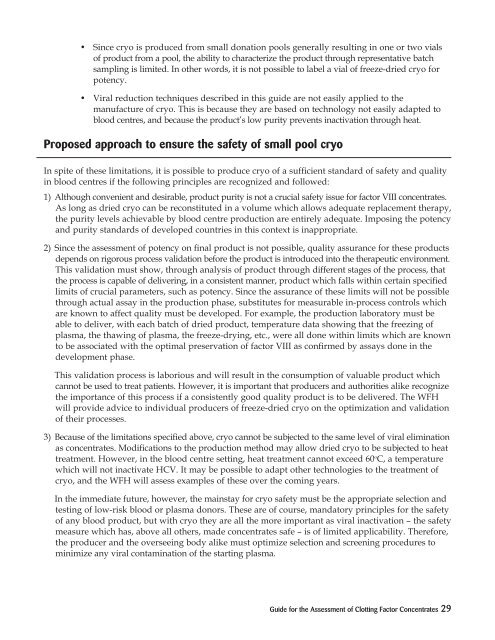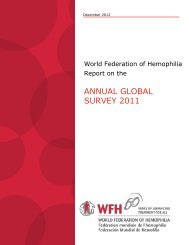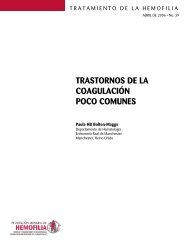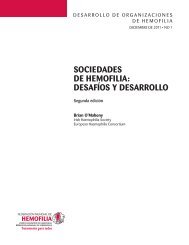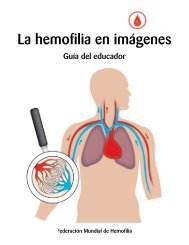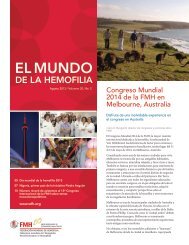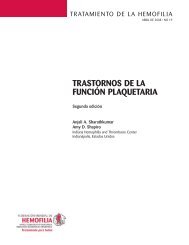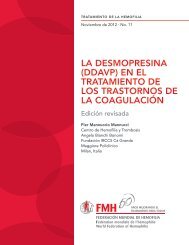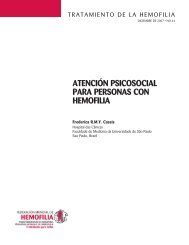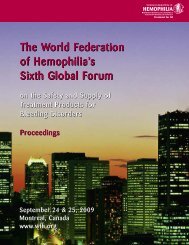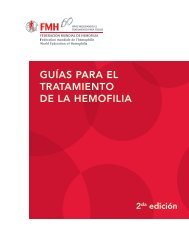Guide for the Assessment of Clotting Factor Concentrates
Guide for the Assessment of Clotting Factor Concentrates
Guide for the Assessment of Clotting Factor Concentrates
You also want an ePaper? Increase the reach of your titles
YUMPU automatically turns print PDFs into web optimized ePapers that Google loves.
• Since cryo is produced from small donation pools generally resulting in one or two vials<strong>of</strong> product from a pool, <strong>the</strong> ability to characterize <strong>the</strong> product through representative batchsampling is limited. In o<strong>the</strong>r words, it is not possible to label a vial <strong>of</strong> freeze-dried cryo <strong>for</strong>potency.• Viral reduction techniques described in this guide are not easily applied to <strong>the</strong>manufacture <strong>of</strong> cryo. This is because <strong>the</strong>y are based on technology not easily adapted toblood centres, and because <strong>the</strong> product’s low purity prevents inactivation through heat.Proposed approach to ensure <strong>the</strong> safety <strong>of</strong> small pool cryoIn spite <strong>of</strong> <strong>the</strong>se limitations, it is possible to produce cryo <strong>of</strong> a sufficient standard <strong>of</strong> safety and qualityin blood centres if <strong>the</strong> following principles are recognized and followed:1) Although convenient and desirable, product purity is not a crucial safety issue <strong>for</strong> factor VIII concentrates.As long as dried cryo can be reconstituted in a volume which allows adequate replacement <strong>the</strong>rapy,<strong>the</strong> purity levels achievable by blood centre production are entirely adequate. Imposing <strong>the</strong> potencyand purity standards <strong>of</strong> developed countries in this context is inappropriate.2) Since <strong>the</strong> assessment <strong>of</strong> potency on final product is not possible, quality assurance <strong>for</strong> <strong>the</strong>se productsdepends on rigorous process validation be<strong>for</strong>e <strong>the</strong> product is introduced into <strong>the</strong> <strong>the</strong>rapeutic environment.This validation must show, through analysis <strong>of</strong> product through different stages <strong>of</strong> <strong>the</strong> process, that<strong>the</strong> process is capable <strong>of</strong> delivering, in a consistent manner, product which falls within certain specifiedlimits <strong>of</strong> crucial parameters, such as potency. Since <strong>the</strong> assurance <strong>of</strong> <strong>the</strong>se limits will not be possiblethrough actual assay in <strong>the</strong> production phase, substitutes <strong>for</strong> measurable in-process controls whichare known to affect quality must be developed. For example, <strong>the</strong> production laboratory must beable to deliver, with each batch <strong>of</strong> dried product, temperature data showing that <strong>the</strong> freezing <strong>of</strong>plasma, <strong>the</strong> thawing <strong>of</strong> plasma, <strong>the</strong> freeze-drying, etc., were all done within limits which are knownto be associated with <strong>the</strong> optimal preservation <strong>of</strong> factor VIII as confirmed by assays done in <strong>the</strong>development phase.This validation process is laborious and will result in <strong>the</strong> consumption <strong>of</strong> valuable product whichcannot be used to treat patients. However, it is important that producers and authorities alike recognize<strong>the</strong> importance <strong>of</strong> this process if a consistently good quality product is to be delivered. The WFHwill provide advice to individual producers <strong>of</strong> freeze-dried cryo on <strong>the</strong> optimization and validation<strong>of</strong> <strong>the</strong>ir processes.3) Because <strong>of</strong> <strong>the</strong> limitations specified above, cryo cannot be subjected to <strong>the</strong> same level <strong>of</strong> viral eliminationas concentrates. Modifications to <strong>the</strong> production method may allow dried cryo to be subjected to heattreatment. However, in <strong>the</strong> blood centre setting, heat treatment cannot exceed 60 o C, a temperaturewhich will not inactivate HCV. It may be possible to adapt o<strong>the</strong>r technologies to <strong>the</strong> treatment <strong>of</strong>cryo, and <strong>the</strong> WFH will assess examples <strong>of</strong> <strong>the</strong>se over <strong>the</strong> coming years.In <strong>the</strong> immediate future, however, <strong>the</strong> mainstay <strong>for</strong> cryo safety must be <strong>the</strong> appropriate selection andtesting <strong>of</strong> low-risk blood or plasma donors. These are <strong>of</strong> course, mandatory principles <strong>for</strong> <strong>the</strong> safety<strong>of</strong> any blood product, but with cryo <strong>the</strong>y are all <strong>the</strong> more important as viral inactivation – <strong>the</strong> safetymeasure which has, above all o<strong>the</strong>rs, made concentrates safe – is <strong>of</strong> limited applicability. There<strong>for</strong>e,<strong>the</strong> producer and <strong>the</strong> overseeing body alike must optimize selection and screening procedures tominimize any viral contamination <strong>of</strong> <strong>the</strong> starting plasma.<strong>Guide</strong> <strong>for</strong> <strong>the</strong> <strong>Assessment</strong> <strong>of</strong> <strong>Clotting</strong> <strong>Factor</strong> <strong>Concentrates</strong> 29


